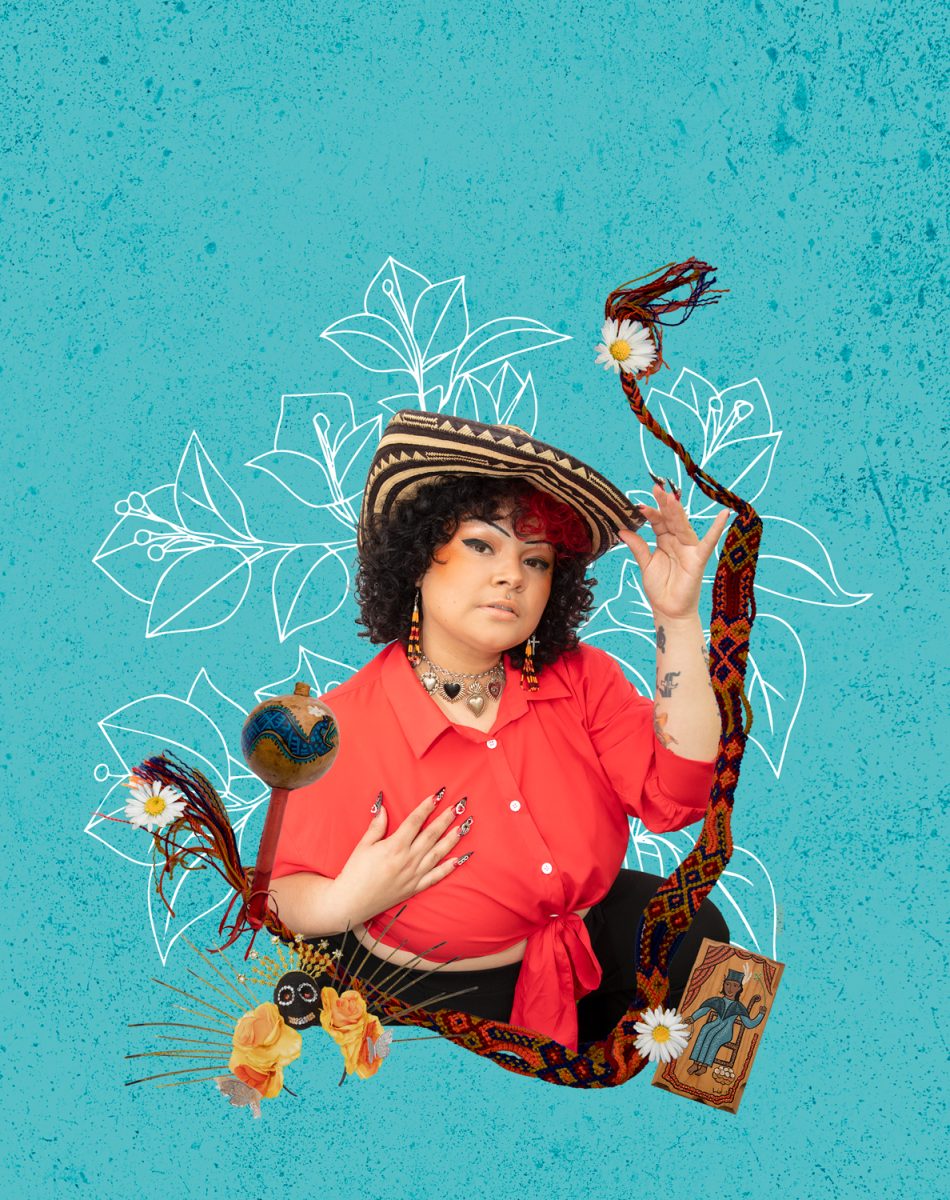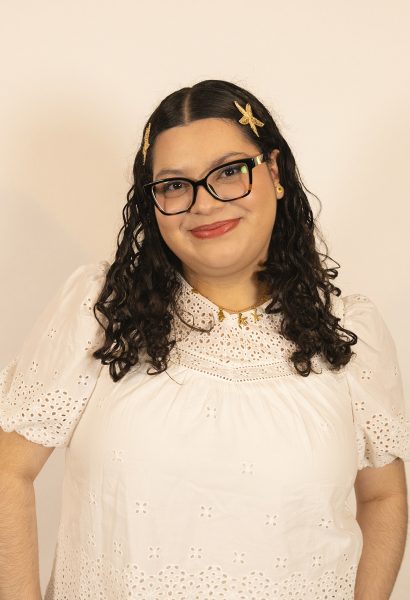On the night of the 2024 U.S. presidential election, the newly re-elected President Donald Trump announced to the American populace that the “golden age” of America had begun. From the sea of red hats gathered in front of him came cheers in celebration. Across the country, Trump’s promise to America was broadcasted to living rooms, bars and classrooms.
Yet, beyond this spectacle, a much different reality was taking shape—one filled with uncertainty and fear. For many, the words “golden age” weren’t a promise for progress, but a signal that the next four years would challenge the fabric of democracy itself. As the night ended in joy for some and despair for others, the question lingered: Whose golden age had just begun and who would be left behind?
“How you kill somebody’s spirit”
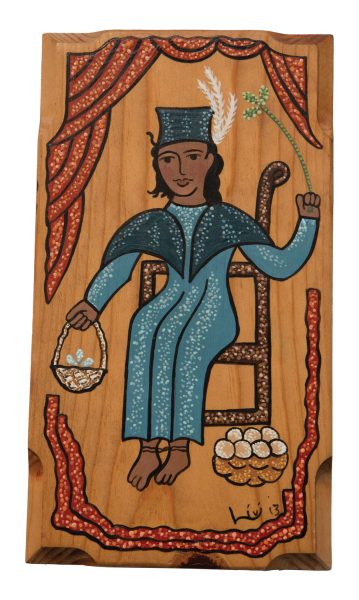
On Trump’s first day in office, he signed dozens of executive orders seeking to limit immigration, responses to climate change and gender rights. A pillar to his re-election campaign, one of the very first executive orders Trump signed called for the mass deportation of undocumented people living in America—resulting in unprecedented ICE raids across the country. The Trump administration has attempted to erase trans and queer identities by only recognizing a “biologically” male-female binary at the federal level—and the use of “gender” has also been replaced with “sex” in federal materials. The Trump administration has also declared that English is the official language of the United States, despite 67.8 million speakers of other languages living in the U.S., according to a 2019 Census Bureau report. Diversity, Equity and Inclusion programs and initiatives across intuitions are being dismantled, leaving marginalized communities more vulnerable to exclusion and discrimination.
For some, these policies aren’t just political. They are a direct attack on many Americans’ daily lives and sense of self.
“Whether you’re being physically hurt or not, you’re still experiencing what I call spirit murder or attempted spirit murder,” says Dr. Anita Tijerina Revilla, professor of Chicana/o and Latina/o Studies at California State University, Los Angeles. “That’s how you kill somebody’s spirit. You take away their language, you take away their gender, sexual identities. You take away their racial, ethnic identities because all these identities all come together and work together to create both a sense of pride and belonging.”
But academics, activists and artists around the country, like Tijerina Revilla, are not standing down. For them, finding joy and actively choosing to love and care for one another is the ultimate act of resistance in a tense political climate, especially under a government that seeks to disorient and erase its people. It’s part of a movement that didn’t start on Nov. 5, 2024, but has been building for decades.
“Spiritually, intellectually, psychologically, we must protect ourselves and we must protect each other’s physical bodies from being harmed,” she says. “The only way to do that is to do it in community, to do it by organizing, to do it through education, and by simply supporting each other.”
In her 1987 book “Borderlands” Chicana lesbian author Gloria Anzaldúa writes, “People, listen to what you’re jotería is saying.” Anzaldúa urges people to acknowledge the radical potential of their queerness. It seems counterintuitive at first. Terms like “joto” or “jota” have long been used as slurs within the Latinx community against people who don’t fit heteronormative standards. While these words have had a history of violence and hatred, there has been a shift among the Latinx LGBTQ+ community to reclaim jotería as a term of empowerment. The Association for Jotería Arts, Activism, and Scholarship, a collective for academics, artists and activists, defines jotería as a “decolonial queer/feminist sensibility and politics, a mode of seeing, thinking, and feeling geared towards empowerment and social transformation.”
Although the specific name for jotería studies is relatively new, the field has its roots in ethnic studies and Chicanx feminist studies/movements from the ’60s-’80s. Formed in the ’90s, the Joto Caucus and the Lesbian, BiMujeres, and Transgender Caucus were groups of queer Latinx academics within the National Association for Chicana and Chicano Studies who addressed homophobia and heterosexism within academia. After members felt frustrated with issues of representation and moments of homophobia and transphobia within NACCS, both groups came together to form a new collective that would address all their intersectionalities beyond academia. In 2011, AJAAS was officially established and held their first conference in 2012 at the University of New Mexico. The forming of AJAAS was one of the key moments that led to the development of jotería studies as a field. The jotería studies dossier in Aztlán: A Journal of Chicano Studies, published in 2014 and edited by Michael Hames-García, is collection of 12 essays on different perspectives on jotería studies and is regarded as the foundational text for the discipline. AJAAS’s conferences have created spaces for community building, healing and organizing across academia, art and activism.
Dr. Omi Salas-SantaCruz, the co-chair of AJAAS and assistant professor of educational philosophy at the University of Utah, emphasizes that healing can be most effective when done in community.
“We cannot heal in the spaces we’ve been harmed,” they say. “So, for us, jotería is this other alternative community where you can come heal and be in community and be in familia.”
Jotería in many ways is a political practice. It is a reminder that existing authentically, and finding joy in that existence, is itself a revolutionary act.
“It’s a way of being and doing. It’s about loving each other and caring for each other in a world that is very limiting and violent,” says Salas-SantaCruz. “It re-signifies that violent term into a term of healing, joy and resistance.”
“You can bring everything you are and not feel judgment”
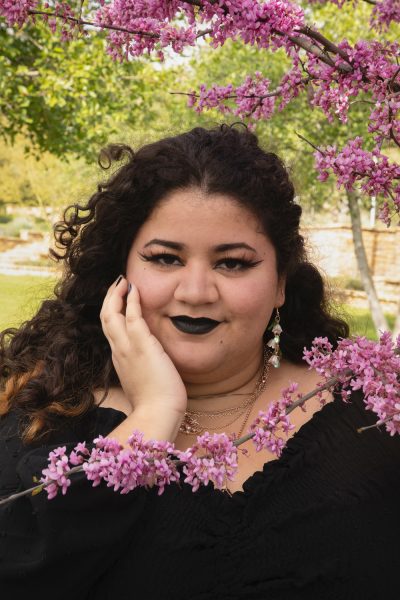
As an undergrad at California State University, Fullerton, Alyssa Barrios embraced her jotería through art. In her first semester at CSUF, Barrios enrolled in two Chicanx Studies courses despite being an illustration major. It was in those courses where she first learned the term jotería.
“Jotería was such a revelation to me because, I was like, oh wow, I can express my own queerness alongside myself being a Chicana,” she says. Growing up in a predominantly white neighborhood, she often felt isolated from her Latinx heritage. As a queer Chicana, she felt she didn’t fit into Latinx spaces because of her distance from the culture, but she also felt a disconnect from queer spaces. “I felt like I wasn’t Latina enough or Chicana enough to really claim being a part of the jotería community.”
In her Chicanx studies courses, Barrios grew closer to her professors and classmates—finding that sense of community she missed growing up. She was introduced to Spoken Wor(l)d Art Performance Activism, or SWAPA, an assignment that required students to perform their responses to texts in front of the class. This was a transformative experience for Barrios. She describes how through these assignments she was able to share vulnerable parts of herself and learn intimate details about her classmates. This had such an impact that Barrios decided to become a double major in both illustration and Chicanx studies.
As her relationship with her identity was healing, Barrios found herself using art as an outlet to express these reclaimed parts of herself.
“In my art too, in every way, I feel more and more like I’m able to put that claim to it and be like, yeah, no, I am a part of the jotería community and owning that it’s more interwoven with me,” she says.
In one of her jotería-inspired projects, Barrios created a black and white live self-portrait, in which she spent ten hours meticulously painting herself in front of a mirror. This was another type of SWAPA art about witnessing oneself and it helped Barrios explore themes of identity and self-discovery.
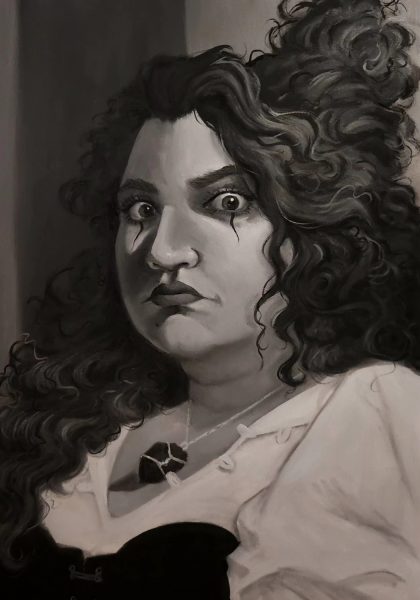
“I’m looking into mirror the whole time, having to look at myself and like, process myself and witness myself,” she says. “And kind of like incorporating different aspects of me, whether it’s my own fatness, whether it’s my queerness, my jotería identity, my Chicana identity, all these other identities that come into play with it.”
Before this class, Barrios says she would have usually approached a self-portrait with a sense of judgement for herself, but now she looks back at her face in the canvas and sees herself with love and cariño.
On Oct. 17, 2024, CSUF’s Latinx Lab for Storytelling and Social Justice hosted its Jotería Studies Symposium for a day of conversations and performances by jotería artists, academics and activists. Barrios was asked to perform at the symposium. Initially, she felt intimated—she would be on the same panel with professors and academics with master’s degrees and Ph.D.s. Barrios performed a piece on coming out as someone who’s queer and an artist. After her performance, other students approached her and thanked her for her vulnerability.
“The biggest thing that I love so much about the jotería community is that you can bring everything you are and not feel judgment for it or like ousted outside of that pocket of community for it,” she says.
Dr. Eddy Franciso Alvarez, chair of the department of Chicana and Chicano Studies at CSUF, was one of Barrios’ mentors during her first semester. He emphasizes the importance of jotería creating a space for individuals to embrace their intersectional identities.
“The type of spaces that we create together are about familia, you know, and about healing and about corazón,” he says.
“What’s kept me alive”
Like Barrios, Jaimé Rodriguez, a writer and poet, is reconnecting with their culture through jotería. Rodriguez grew up in Los Angeles, California and, as the first-born child of religious Colombian and Mexican parents, they often felt the weight of the traditional expectations to be cisgender and heterosexual.
“On the Chicano side of my family, it was more about repression and Catholicism. And then on the Colombian side of my family, it was about assimilating and about becoming more American, becoming more white,” says Rodriguez. “To them, queerness is not involved in any sort of assimilation, it’s a step backwards.”
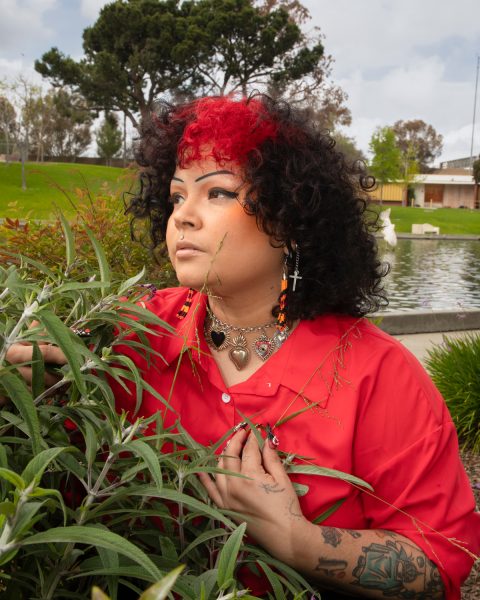
When they discovered that their identity as nonbinary and queer didn’t align with their parents’ expectations, their relationship with their family became strained—further distancing them from their culture. However, Rodirguez found comfort through their writing.
“My passion for writing, I think, is what’s kept me alive,” Rodriguez says. “I’m in a space now where I have access to media and literature that represents me, but I think for a long time I was unconsciously writing myself into existence. I think for a lot of times I felt erased.”
Rodriguez found empowerment in other queer writers and artists of color. Colombian writer and activist Tatiana de la Tierra and punk musicians like Alice Bag and Cristy Road inspired Rodriguez to be loud and confident in their identities. Rodriguez connected with the book “Juliet Takes a Breath,” by Gabby Rivera, a coming-of-age novel about a young Puerto Rican girl leaving her home in the Bronx after coming out to her family.
Seeing their identities reflected in literature and other forms of media is what kept Rodriguez in school. When they began earning their master’s in Latin American Studies at California State University, Los Angeles, Rodriguez first learned the term jotería.
“I think I had been living it for a long time, I just didn’t have the word,” they say.
To them, jotería is “an everyday embodiment of queerness.” Seeing their identity reflected in an academic space provided Rodriguez with the next step in reclaiming jotería. “I think I was looking for permission to exist in wholeness,” says Rodriguez, who now serves as the scholarship liaison for AJAAS. “Discovering jotería was really one of the first times where I was like, oh, I can be an academic, I can be queer, and I can be brown and I can be, you know, all of my intersections at the same time.”
In their poetry, Rodriguez explores themes of queer identity and sexuality. In the poem “Bendiciones and bandanas” Rodriguez sets a scene of being in Mexico City during Pride Month.
“La Zona Rosa is crowded with jotos, glitter and the smell of meat being cooked in the calle./It can be overwhelming when my queerness is shoved down my throat and branded as acceptance,” they write.
Rodriguez rejects the commodification of queerness during Pride Month and instead describes that the real jotería is the passion shared between them and their partner.
“This is the type of joteria that lives on Grinder, in wooded/parks at night, something you’d long for on Lex and tie down on Field, never to be sold/at Target in June.”
When Rodriguez writes, they say it’s for the younger version of themself—writing allows them to create a world where they can thrive.
Rodriguez identifies as Two-Spirit to honor the women in their family and their Indigenous heritage. Two-Spirit does not refer to a specific gender, it is used by Indigenous people who identify with having both masculine and feminine traits, or spirits.
On their mother’s side, Rodriguez is Rarámuri—the native population of Meoqui, Chihuahua, Mexico. Through conversations with their grandmother, Rodriguez had learned the complicated history of their Indigenous family they never learned growing up. After researching family records, Rodriguez discovered that their great-great-grandmother was kidnapped and brought to a mission school in El Paso, Texas. Their great-grandmother was the only survivor of her pueblo that was eventually burned down by Anglicans.
Rodriguez’s journey of uncovering their family’s history also became a journey of reclaiming identity. Through jotería, Rodriguez has been able to grow closer to the heritage they were once separated from. For them, jotería is about embracing joy on their own terms.
“I think in a lot of ways, jotería is like, do what makes you happy,” Rodriguez says. “And if my goal is to connect with people, to connect with myself, I realized I don’t need anyone’s permission to do it.”
“Joto destiny”
While artists in the U.S. are actively reclaiming the term jotería, many in Latin American countries still hesitate to embrace the term. Dr. Luis Osbaldo Esparza, a transnational jotería activist and a professor of Queer Studies and Chicano Studies at California State University, Northridge, was particularly interested in how rural communities in Mexico, like the one where he grew up, were still being affected by a legacy of homophobic, patriarchal, colonial thinking.
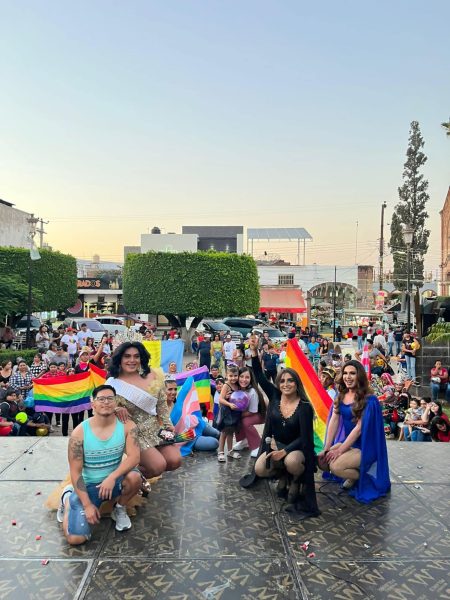
Esparza is originally from Tototlán, Jalisco, Mexico, but was raised in Southern California’s Inland Empire.
“I was detribalized under the context that I was made to feel ashamed of my ruralness, feel ashamed of my Mexicanidad, my Indigeneity,” Esparza says. “I think for a while I was disconnected from my ancestral lands, from my culture.”
When Esparza was pursuing his master’s at California State University, San Bernardino, he went back to Tototlán to attend a party at a rancho (a plot a land, typically a farm).
“I was always taught through my very Eurocentric education that the ranchos are places that are inherently machista or inherently transphobic and homophobic,” Esparza says. “So, I didn’t think this was a space for jotería to exist openly.”
At the party, Esparza reconnected with his long-lost cousins that he never met because they were openly gay in the small pueblo. He says the homophobia that ran deep in his family and culture led to their estrangement, as his relatives shunned them to avoid shame and maintain traditional expectations. This experience is what led Esparza to his master’s thesis—exploring queerness and jotería in rural parts of Mexico through interviews with local queer people in Tototlán.
“I like to say it’s joto destiny,” he says.
His work transformed from theory into practice. After connecting with other queer people in Mexico, Esparza was invited to join the committee for TotoDiverso in 2023—a collective for queer folk in Tototlán. TotoDiverso was in the process of organizing a marcha de orgullo (pride march). However, the government only provided the collective with 500 pesos (about $25) to organize the march. Esparza contacted people he had connected with at the 2019 AJAAS conference in Portland, Oregon, and asked for support. In two weeks, they raised $1,000 from donations of the jotería community—funding the first marcha in Tototlán’s history. TotoDiverso and jotería allies walked through Tototlán waving pride flags and chanting “Toto, Diverso, ahora es el momento!”
“It’s been a journey of healing for me because I’ve been able to reconnect with my communidad over there in meaningful ways and transformative ways,” he says.
Jotería offers a refuge where individuals can live authentically, free from restricting cultural expectations of society or their own families. Esparza believes in the importance of uplifting one another in the jotería community, especially in times of political uncertainty. He finds motivation through his activist work, but he is also inspired by his students.
“It’s draining when you look on social media and see all the executive orders, like they’re doing that on purpose, they want to overwhelm you,” he says. “But when I hear the energies, and when I hear the resistance work the students are doing, it brings me hope.”
This appeared in the Summer 2025 print issue of Inside Fullerton.


